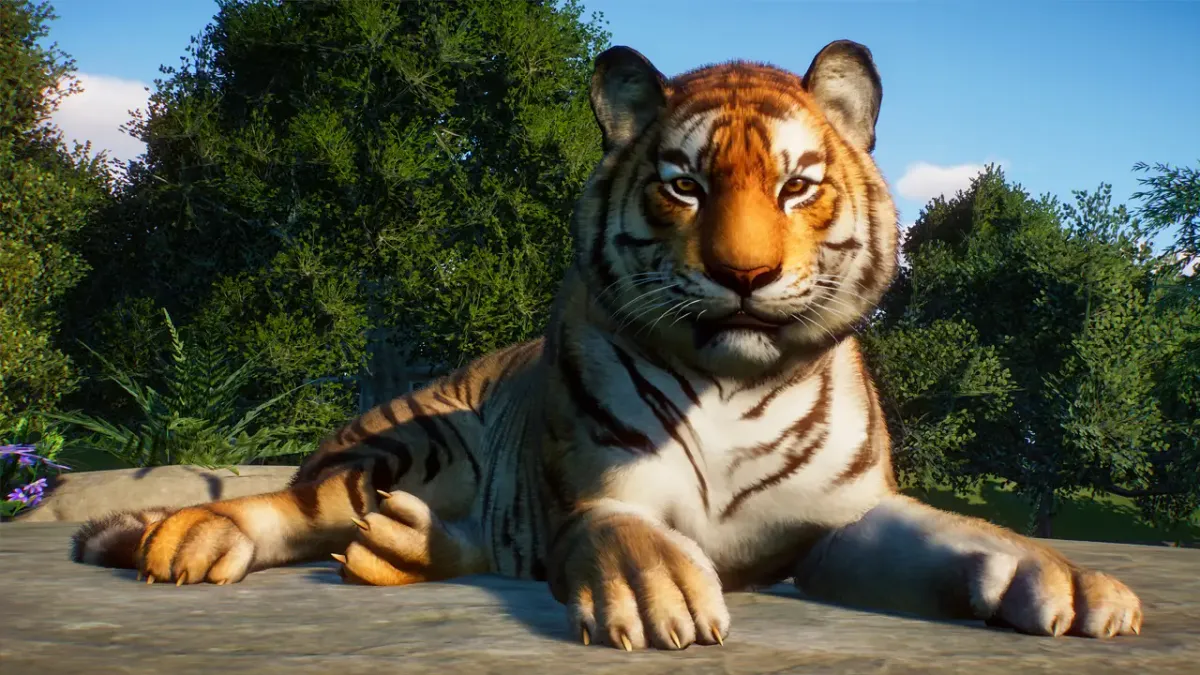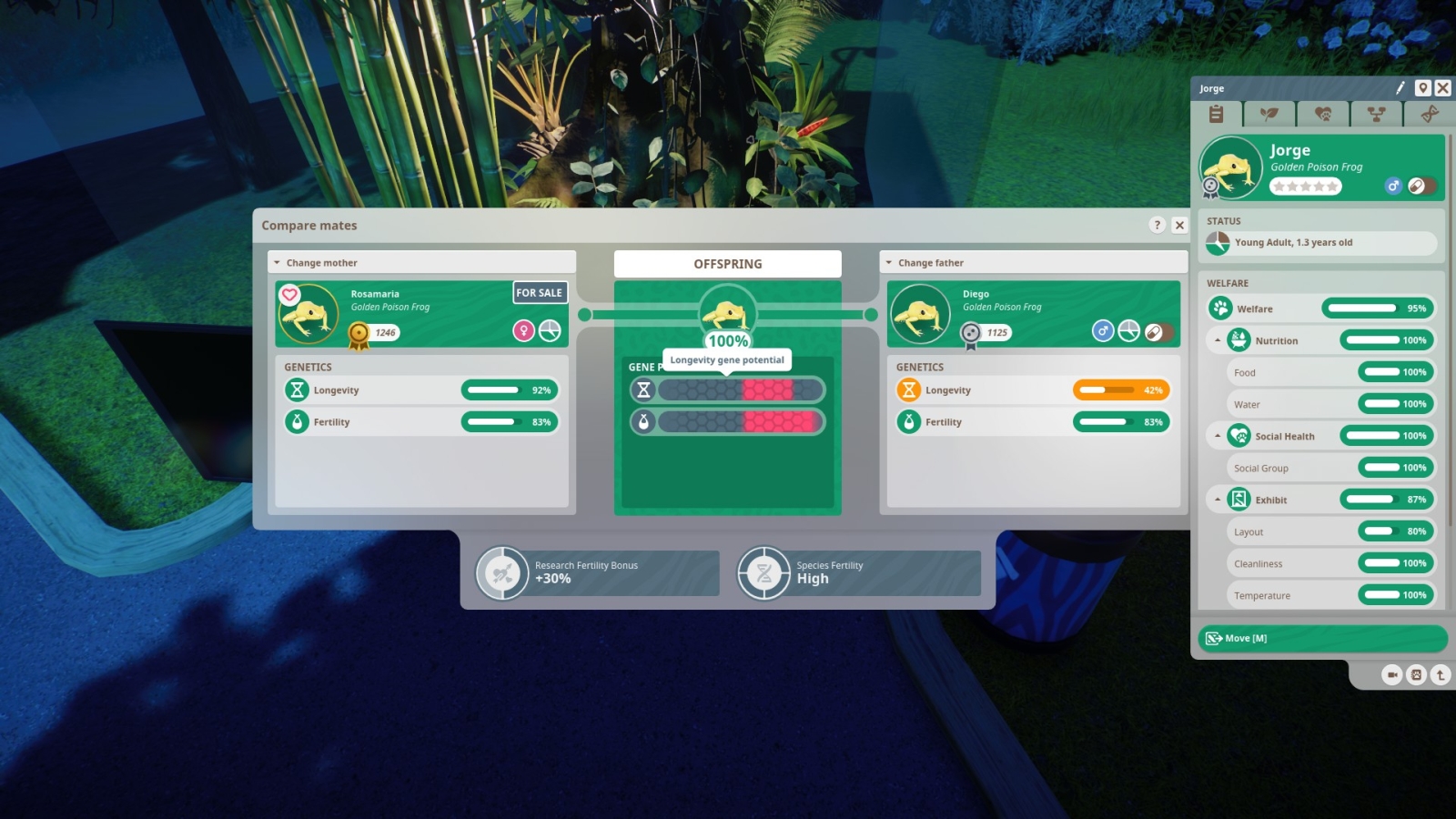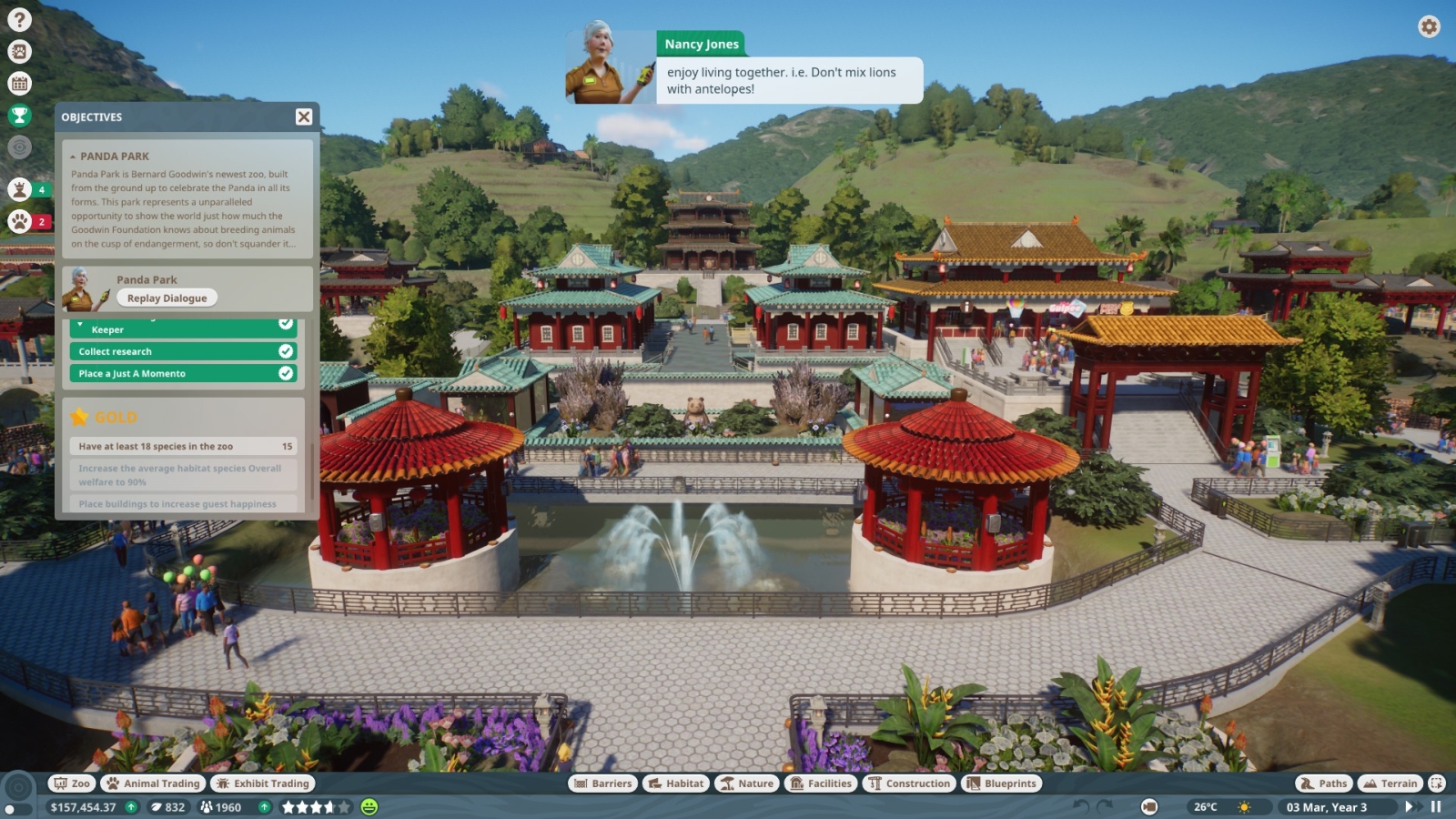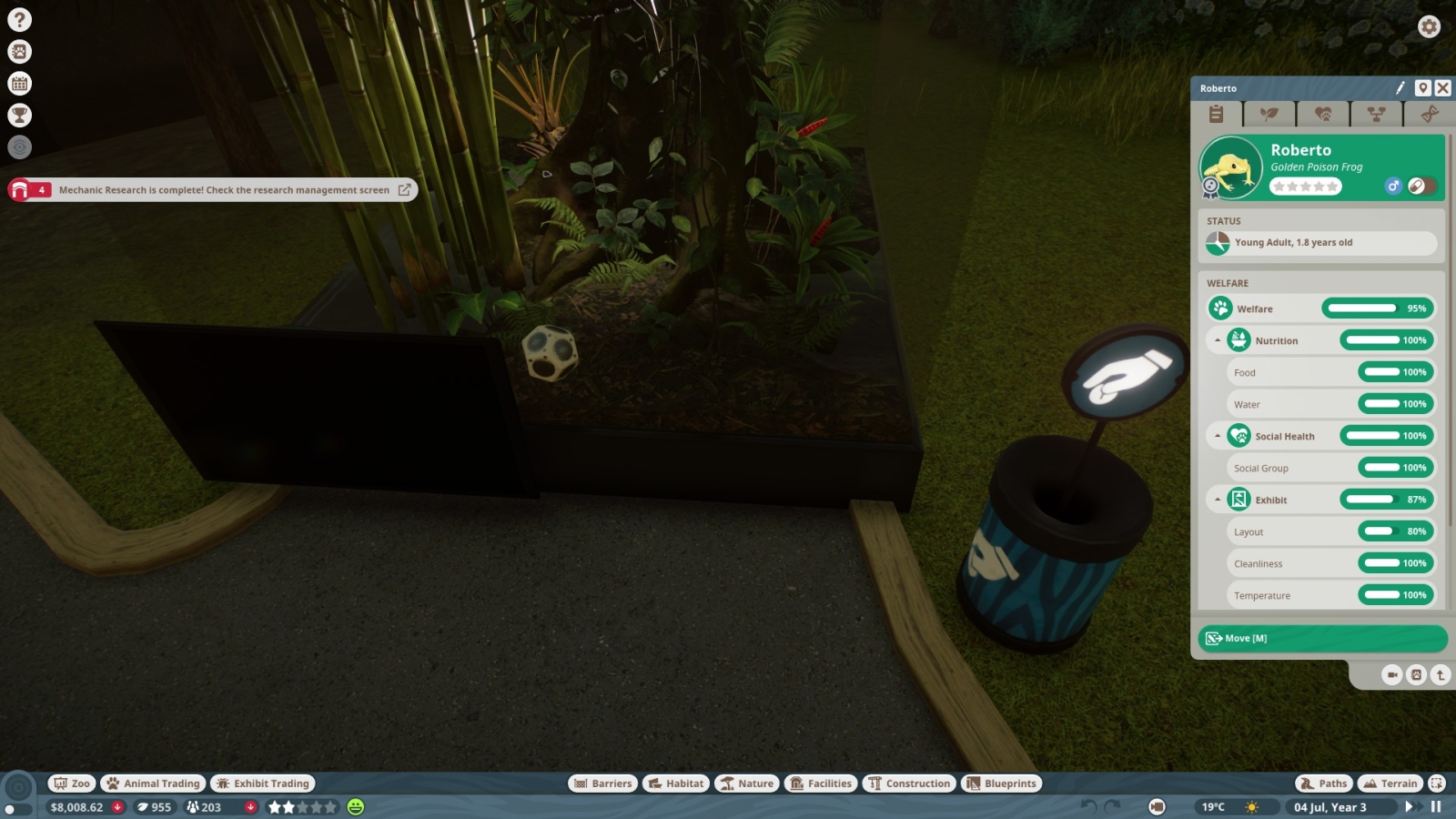
Frontier Developments is one of the most memorable developers of simulation games. Their portfolio is top shelf, with RollerCoaster Tycoon 3 in 2004, Thrillville in 2006, Thrillville: Off the Rails in 2007, Kinectimals in 2010, Kinect: Disneyland Adventures in 2011, Zoo Tycoon in 2013, Planet Coaster in 2016, and Jurassic World Evolution in 2018. While I enjoyed their previous efforts, it was the last three games that really made Frontier one of my favorite game development houses. Sure, I enjoy some open world space action in Elite Dangerous, but building theme parks and running the day-to-day of them is really where my heart lies.
Planet Zoo is, in many ways, the culmination of decades of work. It has elements of every game I mentioned, as well as a few new tricks up its sleeve. As you can see in my review of Planet Coaster, I loved the game, recognizing it as a massive step forward in many areas, including the Workshop (there are over a quarter million fan-made creations available for Planet Coaster), pathing, terrain management, and just overall fun. Jurassic World Evolution (my review) had more personality to it thanks to the Frontier team’s fantastic art department, with each of the 50+ dinosaur species being painstakingly rendered to incredible detail, though I felt the animal management aspects were a little undercooked. Thankfully, Planet Zoo combines the best of both with so much personality I thought my eyes would flip inside out with all the cute baby animals. Let’s get into it.
Planet Zoo, like Frontier’s other management sims, is about running a business. Sure, that business is running a zoo full of amazing creatures, but it’s still a business bent on making money. As such, you’ll be setting prices on your food and drinks, park entrance, and other cash flow items, but there is a second currency at play that creates a deeper connection here. While it’s true you can buy animals from the marketplace and other zoos, there is a secondary currency in conservation credits. By achieving specific objectives you’ll earn credits that you can use to to bring in animals that may have been rescued from bad situations. These hard-luck critters need a new home, and your zoo is the perfect place for them.
Another way your zoo can earn money to benefit your animals is through visitor donations. By putting educational monitors and speakers around your animal pens, and providing a donation box, the public can gift their own money to help conserve their favorite hissing cockroach, snail, tiger, iguanas, or gila monsters. Better education helps push that along, so make sure you keep those donation buckets where your guests can see them.
Penning up creatures for people to gawp at isn’t really why you run a zoo — getting them to breed, perpetuate their species, and releasing them back into the wild is the true purpose. Each creature has a series of stats including longevity and fertility, that determine its eligibility for breeding more little ones, or release back into the wide world with the greatest chance to survive and thrive. If breeding them is your goal, however, you can compare the creatures in your habitat with ones you might pick up from the market, showing the potential offspring you might produce, should you make the adoption and get them to cuddle up with one another. Of course, their habitat layout, cleanliness, humidity, how many creatures are in their habitat, and if they have a log to hide in for their canoodling will make a difference in their overall happiness, so you’ll need to mind all the details. These little details create a world that feels more believable. In fact, when adopting some animals you’ll receive a conservatory credit bonus if you can restore them back to good health. You are not only building amazing homes for these beautiful creatures, you are also improving on their living conditions.
Not unlike their previous efforts, the layout for the different modes of gameplay are Career, Challenge, and Sandbox, with Franchise being added in for good measure. Career, as you would expect, presents a dozen pre-built parks, each with their own challenges. As before, satisfying those conditions provides a bronze, silver, and gold level, though you only need a single star to unlock the next scenario. These are all voice-acted and semi-guided with goals including a specific amount of merch sold, park admissions, or having a wider variety of animal exhibits. More importantly, these serve as a tutorial on all of the various mechanics in the game. For example, the first two levels don’t have any disease risk, but when you visit the Panda level, you’ll go through the process of quarantining, researching and curing the disease, inoculating your animal, and releasing them back into your park. The fourth level really tests what you’ve learned, dropping you off at the edge of a beautiful lake and saying “have at it”, letting you use what you’ve picked up in the previous levels to create a park of your own making. In that scenario, you’ll learn that “more attractive animals attract more guests” — I guess that stands to reason, but I somehow feel attacked. Just the same, it helps you learn how to pull more guests into your park – “bigger, louder, more teeth”.
Challenge lets you build your own park in one of six biomes, utilizing the same park layouts as the career parks, but giving you new unguided challenges to tackle. Like we saw in Planet Coaster, these often escalate with simple objectives being, as an example, adopting four unique species, and advancing to more complex things like eradicating a specific strain of virus that might have infected your animals. If you want to ramp the difficulty, you can also start a zoo from scratch and tackle these same objectives. I’m happy to report the repetitive and randomized challenges we saw in Jurassic World Evolution are now extinct.
Franchise mode matches you up with other zookeepers online, trading animals with other players with a leaderboard-like system that tracks numbers of births, releases, adoptions, and trades, with bronze, silver, and gold trophies for each species. Sandbox, as the name suggests, lets you build a park anywhere you’d like, with no limitations. If you are inclined (and you’ve earned at least one star in the park you want to use), you can even select one of the career zoos and drop it into a sandbox.
All of the improvements that have come to Planet Coaster over the last few years are present here as well. Things like track and terrain collision can be turned off, and HDR lighting can be enabled if you have the hardware, but it also runs remarkably well on older hardware. My laptop has the equivalent of a GeForce 770 and it runs Planet Zoo like a top at 1080p with all of the settings at high.
Easily the most important part of conservation is education, and the zoo is an important part of that. To that end, placing educational signage, kiosks, and audio pods to inform your guests about ecological challenges like bee decline, deforestation, climate change, and many others. Similarly, you can put up monitors to inform people what they are looking at when they visit individual habitats. What’s particularly cool is that there is real information in these kiosks, so you might just learn a thing or two yourself.
Some creatures can cohabitate easily, creating a more natural blended habitat that is sure to make your visitors happy. Interspecies enhancement comes when two animals can not only inhabit the same space, but create a symbiotic relationship with one another. Inside the Zoopedia are reams of information on which animals get along with others, but here’s a protip for you — turtles and peacocks get along perfectly fine, but don’t put lions in with your gazelles. It’s fun for the lions, horrifying for your guests, and bad for business and conservation.
One of the complaints with Planet Coaster was the feeling that the management aspects didn’t have enough depth. Here, there’s an absolute wealth of information about every aspect of your park. Each creature has tons of information on their preferences, and each employee has a ton of useful stats on what they are doing, how they feel about their job, and much more. Similarly, guests have more to say about their park experience, where they’ve been, if they reached into their pocket and bought a balloon or sponsored an animal for adoption, and much more. Similarly, inside of every building is a world of detail. The vet surgery building, instead of being a being a black box that animals go in sick and come out healthy, has operating tables, supplies, masks and gloves, as well as all the rest of the expected implements your veterinarians will use to nurse your critters back to health.
The environments you create for your zoo aren’t just aesthetic. Just like in Jurassic World Evolution, your animals need specific things to be happy. Some creatures like more vertical climbing surfaces, long or short grass, more or less water, hiding spots, tree coverage, or brush and trees that are indigineous to their climate. Similarly, creatures in glass enclosures like snails and lizards need specific heat and humidity, rocks and logs to get away from eyeballs pressing in on them, and other tank elements. These first level elements will help your creature be moderately happy, but to make them truly content you’ll need to spend time in research. The basics are covered with the first level of needs unlocked automatically, but further improvements will require a research station and an assigned veterinarian. Each level of unlock brings new enrichment items, better understanding of that animal and its habitat, and a whole host of additional cool information in the Zoopedia. On the other hand, if conditions in animal environments get bad enough, you’ll eventually attract protesters. They will picket outside the habitat for the creature, irritating your guests, but more importantly, reminding you that this is a living, breathing creature in need of help.
Research isn’t just limited to killing off disease and improving animal habitats, you’ll also need to take care of the animals paying the bills — your guests. In your workshop, mechanics can research new theming, rides, shops, and improvements to help you grow your bottom line and put balloons and hats in the hands of your guests.
Speaking of creation, Planet Zoo supports the Steam Workshop. In fact, there are already over 10,000 objects in the workshop just from the closed beta test. Blueprints of brand new paddocks, shops, sceneries, statues, shelters, and much more will be ready to go the moment the public gets their hands on this game, and based on what we’ve seen with their other titles, the number, complexity, and ingenuity will only increase from there.
There are some hiccups in Planet Zoo that, hopefully, will get ironed out before or slightly after launch. There are still challenges with pathing, you still can’t lay down a pad to create a large pavillion-like space, and grass still grows through the concrete at times. Your visitors still get bunched up, even in the widest of walkways and within developer-built spaces. I’ve had monkeys climb up on top of the roof of their habitats and then get stuck there, dehydrating, starving, and unable to get down. Similarly, I put my generators up on a hill, not remembering that they’d eventually need maintenance. Any attempts to relocate these generators onto flat ground left them levitating three feet in the air, or dug 8 feet into the ground, neither of which my mechanics would touch, meaning they sat there to rot until they stopped working. These bugs aren’t insurmountable, they just break immersion. These minor bugs, combined with a few crashes to desktop, can be frustrating, for sure.
Planet Coaster
Excellent
Planet Zoo is the culmination of the best parts of Frontier’s previous efforts, but is far more than the sum of its parts. Hundreds of creatures, both cute and deadly, need homes, and it’s up to you to help them thrive and survive. While a few bugs hamper the overall experience, this is another simulation game that’ll keep me building sprawling and ever evolving parks for hundreds of hours to come.
Pros
- Runs remarkably well on a GeForce 770
- Management aspects are much improved
- Conservation moments are genuinely touching
- New biomes and theming are gorgeous
- Huge roster of animals and insects to adopt
Cons
- Some bugs remain
- Pathfinding and path crowding gets to be a nuisance
- Two crashes to desktop






